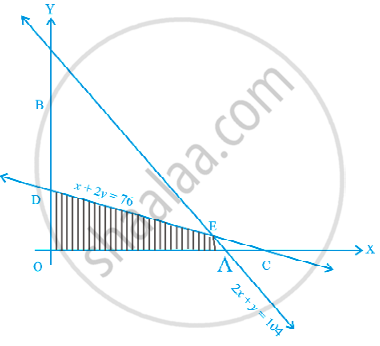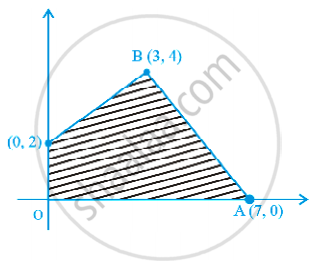Advertisements
Advertisements
Question
A manufacturer produces two Models of bikes-Model X and Model Y. Model X takes a 6 man-hours to make per unit, while Model Y takes 10 man-hours per unit. There is a total of 450 man-hour available per week. Handling and Marketing costs are Rs 2000 and Rs 1000 per unit for Models X and Y respectively. The total funds available for these purposes are Rs 80,000 per week. Profits per unit for Models X and Y are Rs 1000 and Rs 500, respectively. How many bikes of each model should the manufacturer produce so as to yield a maximum profit? Find the maximum profit.
Solution
Let x and y be the number of Models of bike produced by the manufacturer.
Given information is
Model X takes 6 man-hours to make per unit
Model Y takes 10 man-hours to make per unit
Total man-hours available = 450
∴ 6x + 10y ≤ 450
⇒ 3x + 5y ≤ 225 ......(i)
Handling and marketing cost of Model X and Y are ₹ 2,000 and ₹ 1,000 respectively
Total funds available is ₹ 80,000 per week
∴ 2000x + 1000y ≤ 80,000
⇒ 2x + y ≤ 80 ......(ii)
And x ≥ 80, y ≥ 0
Profit (Z) per unit of models X and Y are ₹ 1,000 and ₹ 500 respectively
So, Z = 1000x + 500y
The required LPP is
Maximise Z = 1000x + 500y subject to the constraints
3x + 5y ≤ 225 .......(i)
| x | 0 | 75 |
| y | 45 | 0 |
2x + y ≤ 80 ......(ii)
| x | 0 | 40 |
| y | 80 | 0 |
x ≥ 0, y ≥ 0 ......(iii)
On solving equation (i) and (ii)
We get, x = 25, y = 30
Here, the feasible region is OABC
Whose corner points are O(0, 0), A(40, 0), B(25, 30) and C(0, 45).
Let us evaluate the value of Z.
| Corner points | Value of Z = 1000x + 500y | |
| O(0, 0) | Z = 0 + 0 = 0 | |
| A(40, 0) | Z = 1000(40) + 0 = 40,000 | ← Maximum |
| B(25, 30) | Z = 1000(25) + 500(30) = 40,000 | ← Maximum |
| C(0, 45) | Z = 0 + 500(45) = 22500 |
Hence, the maximum profit is ₹ 40,000 by producing 25 bikes of Model X and 30 bikes of Model Y.
APPEARS IN
RELATED QUESTIONS
Two tailors, A and B, earn Rs 300 and Rs 400 per day respectively. A can stitch 6 shirts and 4 pairs of trousers while B can stitch 10 shirts and 4 pairs of trousers per day. To find how many days should each of them work and if it is desired to produce at least 60 shirts and 32 pairs of trousers at a minimum labour cost, formulate this as an LPP
Solve the following Linear Programming Problems graphically:
Minimise Z = 3x + 5y
such that x + 3y ≥ 3, x + y ≥ 2, x, y ≥ 0.
Show that the minimum of Z occurs at more than two points.
Minimise and Maximise Z = 5x + 10 y
subject to x + 2y ≤ 120, x + y ≥ 60, x – 2y ≥ 0, x, y ≥ 0.
Show that the minimum of Z occurs at more than two points.
Minimise and Maximise Z = x + 2y
subject to x + 2y ≥ 100, 2x – y ≤ 0, 2x + y ≤ 200; x, y ≥ 0.
Show that the minimum of Z occurs at more than two points.
Maximise Z = x + y, subject to x – y ≤ –1, –x + y ≤ 0, x, y ≥ 0.
Refer to Example 9. How many packets of each food should be used to maximize the amount of vitamin A in the diet? What is the maximum amount of vitamin A in the diet?
An aeroplane can carry a maximum of 200 passengers. A profit of Rs 1000 is made on each executive class ticket and a profit of Rs 600 is made on each economy class ticket. The airline reserves at least 20 seats for executive class. However, at least 4 times as many passengers prefer to travel by economy class than by the executive class. Determine how many tickets of each type must be sold in order to maximize the profit for the airline. What is the maximum profit?
The minimum value of the objective function Z = ax + by in a linear programming problem always occurs at only one corner point of the feasible region
Maximise Z = 3x + 4y, subject to the constraints: x + y ≤ 1, x ≥ 0, y ≥ 0
Determine the maximum value of Z = 3x + 4y if the feasible region (shaded) for a LPP is shown in Figure
Feasible region (shaded) for a LPP is shown in Figure. Maximise Z = 5x + 7y.
Refer to question 15. Determine the maximum distance that the man can travel.
Refer to question 15. Determine the maximum distance that the man can travel.
A company makes 3 model of calculators: A, B and C at factory I and factory II. The company has orders for at least 6400 calculators of model A, 4000 calculator of model B and 4800 calculator of model C. At factory I, 50 calculators of model A, 50 of model B and 30 of model C are made every day; at factory II, 40 calculators of model A, 20 of model B and 40 of model C are made everyday. It costs Rs 12000 and Rs 15000 each day to operate factory I and II, respectively. Find the number of days each factory should operate to minimise the operating costs and still meet the demand.
The corner points of the feasible region determined by the system of linear constraints are (0, 0), (0, 40), (20, 40), (60, 20), (60, 0). The objective function is Z = 4x + 3y ______.
Compare the quantity in Column A and Column B
| Column A | Column B |
| Maximum of Z | 325 |
Corner points of the feasible region for an LPP are (0, 2), (3, 0), (6, 0), (6, 8) and (0, 5). Let F = 4x + 6y be the objective function. The Minimum value of F occurs at ______.
A linear programming problem is as follows:
Minimize Z = 30x + 50y
Subject to the constraints: 3x + 5y ≥ 15, 2x + 3y ≤ 18, x ≥ 0, y ≥ 0
In the feasible region, the minimum value of Z occurs at:
A linear programming problem is one that is concerned with ____________.
In linear programming, optimal solution ____________.
In Corner point method for solving a linear programming problem, one finds the feasible region of the linear programming problem, determines its corner points, and evaluates the objective function Z = ax + by at each corner point. Let M and m respectively be the largest and smallest values at corner points. In case feasible region is unbounded, M is the maximum value of the objective function if ____________.
If two corner points of the feasible region are both optimal solutions of the same type, i.e., both produce the same maximum or minimum.
Maximize Z = 3x + 5y, subject to x + 4y ≤ 24, 3x + y ≤ 21, x + y ≤ 9, x ≥ 0, y ≥ 0.
Maximize Z = 7x + 11y, subject to 3x + 5y ≤ 26, 5x + 3y ≤ 30, x ≥ 0, y ≥ 0.
Maximize Z = 6x + 4y, subject to x ≤ 2, x + y ≤ 3, -2x + y ≤ 1, x ≥ 0, y ≥ 0.
